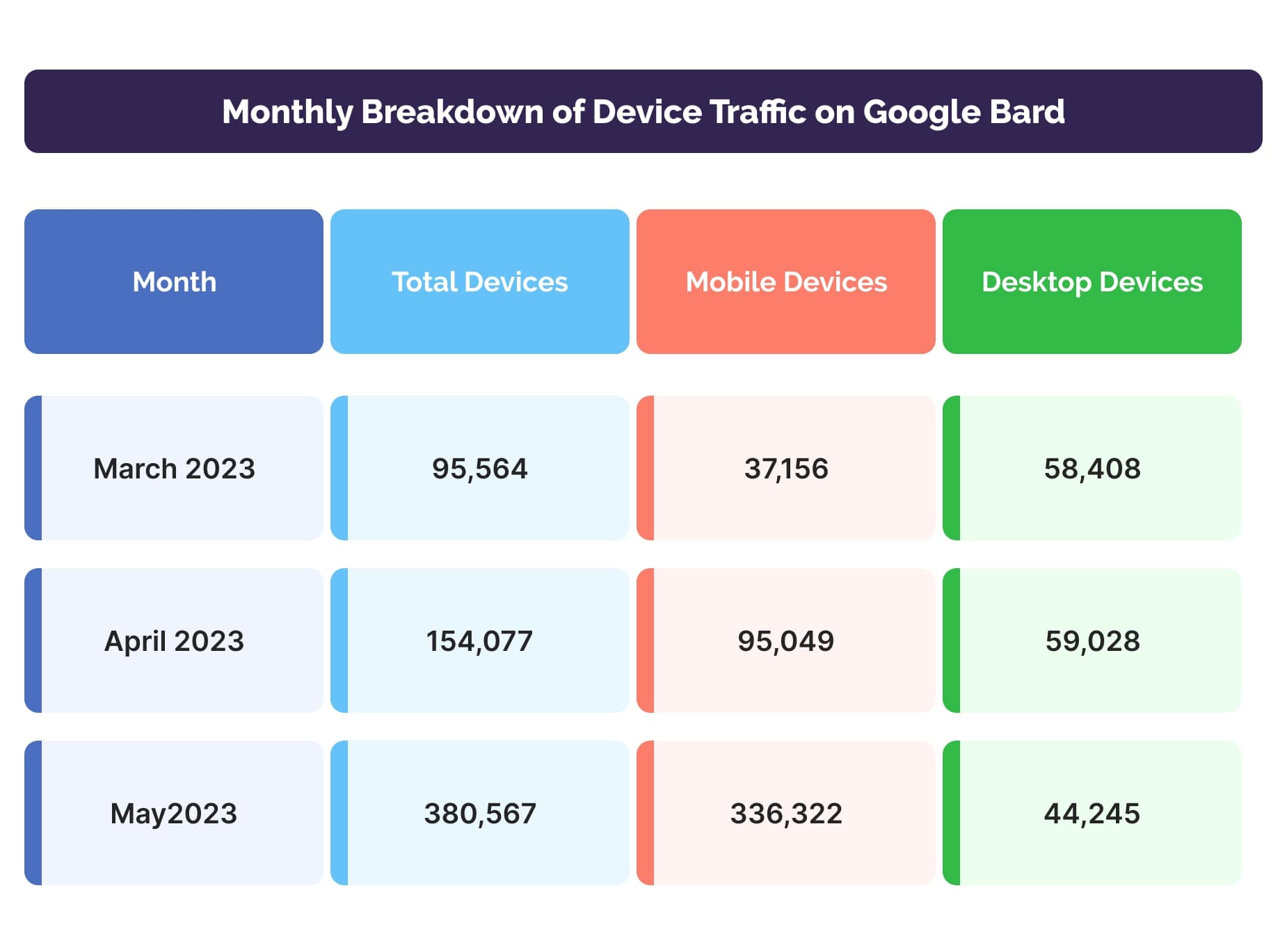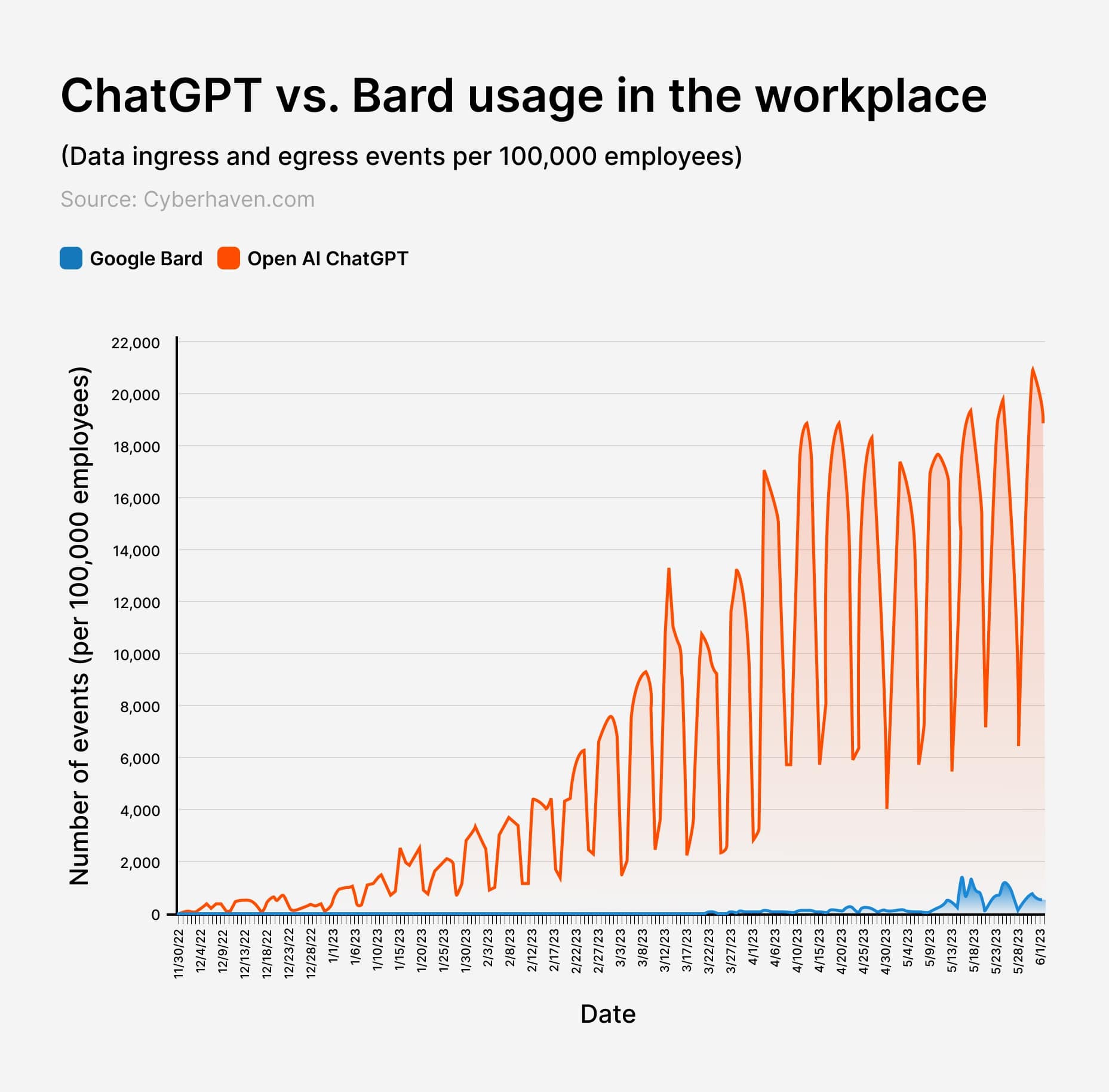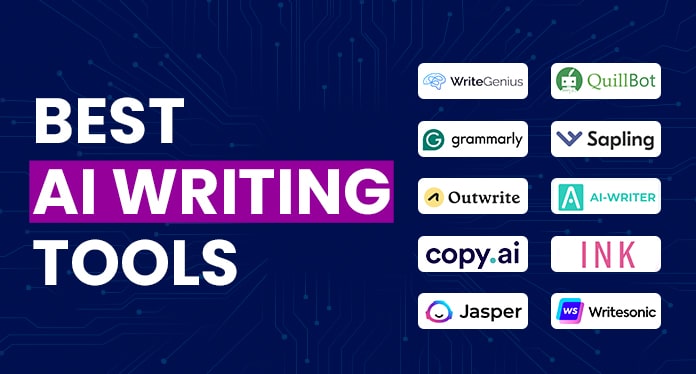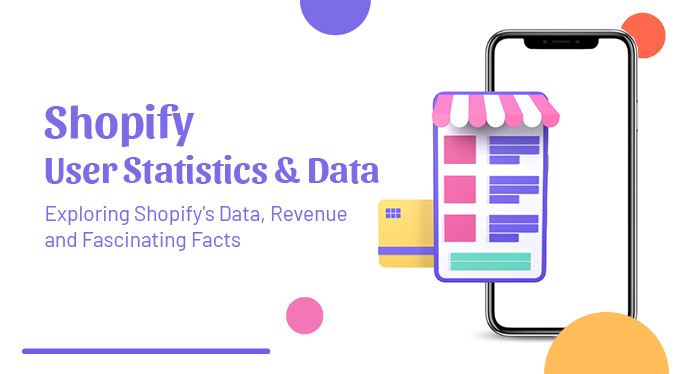Google Bard is taking the world by storm.
Since its release in March 2023, Google Bard has been updated numerous times which has significantly improved its performance. And, recently with the latest February update, Bard was renamed to Gemini. It’s worth noting that Bard has amassed over 30 million monthly active users. That’s a lot of people using this powerful language model to research topics, create content, and just have fun.
But who are these users? Where are they from? And what are they using Google Bard for? In this article, we’ll take a look at some of the latest Google Bard user statistics. We’ll see who’s using it, where they’re using it from, and what they’re using it for.
If you’re thinking about using Bard, take this deep dive into the numbers and figures that run the game, and let us give you the information you need to make an informed decision about whether or not Google Bard is right for you. But before that, let us understand what Bard is…
What is Google Bard?
Google Bard is an AI platform that can understand and generate human-like text responses. It is built on top of Google’s Transformer model, which is a powerful language model that has been trained on a massive dataset of text and code.
The name “Bard” is a reference to the Celtic tradition of bards, who were professional storytellers, verse-makers, music composers, oral historians, and genealogists, employed by a patron to praise them or their ancestors. The word “bard” comes from the Celtic word bardos, which means “poet, seer, learned man”.
A Brief Look At The History Of Google Bard
| Date | Event | Details |
| February 2023 | Google announces Bard at its I/O developer conference. | Bard is announced as a new AI-powered language model that can understand and generate human-like text responses. It is still under development at this point, but Google says that it has the potential to be a powerful tool for research, creativity, and productivity. |
| March 2023 | Google releases Bard in beta to a limited number of users. | Bard is released in beta to a limited number of users to gather feedback and improve the model before it is released to the public. |
| May 2023 | Google makes Bard more widely available. | Bard is made more widely available to the public. |
| July 2023 | Google Bard has over 30 million monthly active users. | By reaching this milestone, Bard has become one of the most popular AI-powered language models in the world, and is expected to take on ChatGPT in the coming days. |
Bard can be used for a variety of tasks, including
- Answering questions in a comprehensive and informative way, even if they are open-ended, challenging, or strange.
- Generating different creative text formats of text content, like poems, code, scripts, musical pieces, emails, letters, etc.
- Translating languages.
- Summarizing text.
- Writing different kinds of creative content.
Bard is still under development, but it has already learned to perform many of these tasks very well. It is a powerful tool that can be used for research, creativity, and productivity.
Popular Google Bard Statistics (Editor’s Pick)Popularity:
Cost:
Usage:
Errors:
|
Quick Facts About Google Bard
- Bard is powered by Google’s most advanced large language model (LLM) PaLM 2, which was unveiled at Google I/O 2023.
- Bard was initially powered and maintained using a lightweight model of LaMDA, because it required less computing power and could be scaled to more users.
- LaMDA was built on Transformer, Google’s neural network architecture that it invented and open-sourced in 2017.
- Bard was trained using 1.56 trillion words from a public dataset referred to as the Infiniset Dataset Composition.
- Bard was introduced on February 6, 2023, in an official statement from the CEO of Google and Alphabet, Sundar Pichai.
- Bard is meant to function similarly to ChatGPT, however, the biggest difference between the two is the source from which information will be pulled.
- Bard’s information pool is essentially the internet, while ChatGPT is entirely based on the training the model received.
- Bard is an experimental system designed to show users the basic and advanced capabilities of a chatbot.
Google Bard User Demographics Statistics
Google Bard is a relatively new tool, so there is not a lot of data available about its user demographics. However, some general trends have emerged both globally and in India.
Google Bard Global Demographics
- Age: The majority of the global Google Bard users are between the ages of 18 and 34.
- Gender: Male users make up 60% of Google Bard users, while female users make up 40%.
- Location: Google Bard users are scattered worldwide, but a large majority of them are found in the United States, Europe and Asia.
- Occupation: The most common occupations of Google Bard users are students (30%), professionals (25%), and entrepreneurs (15%).
- Education: Most users of Bard are well-educated and have a minimum of one degree or higher.
A few additional data points to consider in terms of user demographics of Google Bard:
Google Bard Is
- Popular in countries that exercise a higher level of internet penetration.
- Mostly used to aid in marketing, sales, and academic gain.
Google Bard Monthly Visit Statistics
- Bard.google.com, the larger platform, saw substantial user engagement, starting with 213.1 million visits in September, which increased to 319.6 million in October, and remained strong at 426.1 million in November.
- In contrast, bardai.io, a more specialised platform, had comparatively lower visitor numbers, recording 160.7 thousand visits in June, 104.5 thousand in July, and 96.3 thousand in August. These fluctuations in user activity were evident during the summer months.
- The top keyword, “bard,” garnered significant attention with 2.4 million searches, indicating strong user interest.
- “Google Bard” closely followed with 2.1 million searches, suggesting a specific interest in this AI-powered chatbot.
- “Bard AI” received substantial attention with 751,000 searches, while “Bard Google” recorded 483.9 thousand searches, reflecting curiosity about AI within the context of Google.
- “Google Bard AI” rounded out the list with 127.9 thousand searches, highlighting a more specific query.
- Collectively, these search terms provide a comprehensive view of user engagement with Bard-related keywords, with a few other queries contributing 8.5 thousand searches.
Google Bard Professional Demographics
The professional demographics of Google Bard users are diverse, but some patterns are quite evident. It is important to note that these are just general trends, and there is a lot of variation within each professional group.
Tech Industry:
- 60% of tech professionals use Google Bard at their workplace.
- Of the tech professionals, 40% of them use the platform to generate code and 20% to comprehend and analyse documentation.
- Another 20% of the working professionals also seek out the assistance of Google Bard to create poignant and impressive presentations.
Education:
- 50% of educators globally use Google Bard to address academics-related queries.
- 30% of educators employ the services of the AI platform to create outlines for lesson plans.
- Around 10% of both educators and students use Bard to write feedback to each other and others involved.
Customer Service:
- 40% of customer service representatives worldwide use the assistance of the AI platform to manage customer queries and requests.
- 20% of the customer service representatives use Bard to answer direct and simple queries put forth by the clients including how-tos, what, where, and why questions about the respective products.
- 15% of the customer service professionals use Bard suggests a higher demand for resolving basic issues and basic, professional support.
Google Bard Usage Statistics
Google Bard has had a significant impact since its inception in 2023. It has been used by millions of people around the world for a variety of purposes, including research, creativity, and productivity.
Some of the most notable impacts of Google Bard include
- Increased productivity: Google Bard has helped people to be more productive by automating tasks and providing access to information more quickly. For example, businesses have used Google Bard to generate reports, write emails, and create presentations.
- Improved research: Google Bard has helped people to conduct research more effectively by providing access to a vast amount of information and helping to identify patterns and trends. For example, students have used Google Bard to research topics for their essays and papers.
- Enhanced creativity: Google Bard has helped people to be more creative by providing new ways to express themselves and generate new ideas. For example, artists have used Google Bard to write poems, compose music, and create stories.
Let’s quickly take a brief glance at some of the highlights:
Google Bard:
- Has created over 100,000 presentations.
- Answered an approximate amount of 10 million questions.
- Is available in over 180 countries and territories as of today.
- Is used by people in over 100 languages.
- Can generate text at a rate of 10,000 words per minute.
- Is trained using a dataset of about 1.56 trillion words.
- Has over 137 billion different parameters.
- Can translate languages at the speed of 100 words per second.
- Can create, write compose, and convert one form of text into another.
- Can answer most questions, given they are open-ended.
- Is aware of its limitations and admits to its flaws.
Google Bard: More About the Users
Google Bard, despite its rocky foundations and the hurried manner in which it entered the AI market, has exceeded all of the market expectations regarding user traffic and site visits. Below, we have collated some of the frequently sought data about Bard’s user traffic and this should provide an overview of the excellent performance of the platform against its fast-emerging and established competitors.
- Bard witnesses an average of 142.6 million monthly visits. However, the sharp rise in its viewership occurred in March reaching about 30 million. It is interesting to note that, March 2023 was when Bard was made public for common netizens.
- Most of Bard’s users are situated in the United States of America (62.6%) and is closely followed by UK and China.
- Bard gets around 49.7 million unique visitors every month beating the average from its early months of public release.
- The average time spent by a user on the platform is about 3.19 minutes at a time.
- The median age of Bard’s users is roughly calculated to be between 25-34.
- The services of the AI platform are particularly sought out by professionals in the tech, education, development, computer electronics, project management, customer service, and digital marketing industries.
Web Users Use Google Bard For

- Content Creation– 30% (writing poems, stories, copies, captions and scripts).
- Productivity– 20% (building plans and routines to complete activities).
- Entertainment– 10% (Discover and play games, watch videos, listen to music, find books, discover websites etc)
- The predicted cost per query on Google Bard is between $0.003 and $0.028 and has the potential to become a substantial challenge with the increase in the duration of conversation requests and site visits.
How Was Google Bard Trained?
Google Bard uses Google’s internal directory to address consumer requests. It was trained using data collectively referred to as the Infiniset Dataset Composition. While the term may sound rather daunting, it simply refers to an extensive collection of text and code used to train the platform. This includes data from various sources such as dialogues, existing forum messages, and C4-based data. The table below offers a detailed look into the training dataset Google Bard uses:
| Type of Training Dataset Used | The Overall Share of Dataset in Training the Platform |
| Dialogue Data from Forum | 50% |
| C4-based Data | 12.5% |
| English Wikipedia | 12.5% |
| Code Documents | 12.5% |
| English Web Docs | 6.3% |
| Non-English Web Docs | 6.3% |
Google Bard Traffic Statistics
Google Bard has seen a significant increase in traffic since its release in 2023. In the first month of its release, Bard(dot)Google(dot)com received over 30 million visits. By March 2023, that number had grown to 142 million visits.
The majority of traffic to Google Bard comes from the United States, followed by the United Kingdom, India, and Japan. The traffic is also fairly evenly split between desktop and mobile devices.
The most popular use for Google Bard is for research, followed by creativity and productivity. People are using Google Bard to find information, generate text, and translate languages.
There are also some interesting trends in Google Bard usage. For example, the use of Google Bard for research has increased by 20% in the past year. Additionally, the use of Google Bard for creativity has increased by 15% in the past year.
Top Countries Contributing To Google Bard’s Site Traffic In 2023
| Top Countries | Percentage Contribution of Google Bard Traffic |
| The United States | 37.24% |
| India | 9.56% |
| Japan | 6.67% |
| The United Kingdom | 5.44% |
| Australia | 2.53% |
| Others | 38.56% |
Device Traffic Data for Google Bard
In terms of the devices involved, Google Bard sees the maximum amount of traffic from mobile platforms in the US, while in the UK, 100% of the traffic is attributed to desktop devices. A detailed analysis of device traffic is given below:
| Country | Mobile Traffic | Desktop Traffic |
| The United States | 90.74% | 9.26% |
| The United Kingdom | 0% | 100% |
| Ireland | 100% | 0% |
| Canada | 0% | 100% |
| Australia | 0% | 100% |

| Monthly Breakdown of Device Traffic on Google Bard | |||
| Month | Total Devices | Mobile Devices | Desktop Devices |
| March 2023 | 95,564 | 37,156 | 58,408 |
| April 2023 | 154,077 | 95,049 | 59,028 |
| May 2023 | 380,567 | 336,322 | 44,245 |
Google Bard Traffic Sources
Google Bard receives traffic from a variety of sources, including direct traffic, organic search, and referrals.
Direct traffic is when people type the URL of Bard.Google.com directly into their browser. This is the most common source of traffic to Google Bard, accounting for over 67% of all traffic.
Organic search is when people find Google Bard through search engines like Google and Bing. Referrals are when people find Google Bard through other websites. This is the third most common source of traffic to Google Bard, accounting for over 4% of all traffic.
Other sources of traffic to Google Bard include social media, email, and ads.
The traffic sources for Google Bard are constantly changing. For example, the share of direct traffic has been increasing in recent months, while the share of organic search traffic has been decreasing.
| Possible Traffic Sources on Google Bard | Contribution Towards Traffic |
| Direct | 76.74% |
| Organic Search | 16.77% |
| Referral | 2.92% |
| Social | 1.88% |
| Paid Search | 1.50% |
| 0.16% | |
| Display | 0.02% |
Google Bard’s Social Media Traffic Statistics
Social media is a major source of traffic for Google Bard. The most popular social media platforms for Google Bard are Twitter, YouTube, and Facebook.
YouTube is the most popular social media platform for Google Bard, accounting for over 38% of all social media traffic, followed by Twitter and Facebook. Other social media platforms that drive traffic to Google Bard include LinkedIn, Reddit, and TikTok.
| Social Platforms | Share of Social traffic of Google Bard |
| YouTube | 52.19% |
| 14.16% | |
| 8.82% | |
| 5.61% | |
| 8.58% | |
| Others | 10.64% |
ChatGPT vs. Google Bard – Usage In The Workplace

Both ChatGPT and Bard are powerful AI-powered language models that can be used for a variety of tasks.
ChatGPT is an advanced language model developed by OpenAI. Designed with state-of-the-art artificial intelligence capabilities, ChatGPT excels in comprehending and generating human-like text. With its vast knowledge and natural language processing skills, ChatGPT offers a reliable and proficient conversational experience.
Conversely, Google Bard is a large language model (LLM) chatbot developed by Google AI. It is based on the LaMDA (Language Model for Dialogue Applications) architecture and is trained on a massive dataset of text and code. Bard can answer your questions in a comprehensive and informative way, even if they are open-ended, challenging, or strange.
| Feature | ChatGPT | Bard |
| Model | GPT-3 | LaMDA |
| Training Data | Web text | Web text, code, and other structured data |
| Capabilities | Answer questions, generate text, translate languages, generate and edit code, etc. | Answer questions, generate text, translate languages, write different kinds of creative content, allow text-to-speech responses, integrate with the Google Workspace and Lens, allow version drafts, offer in-built choices for tone, etc. |
| Availability | Free, also has a paid version | Free, also has a paid version |
ChatGPT Vs. Google Bard – Pros and Cons
| Pros | ChatGPT | Google Bard |
| Can generate human-like text | ✔ | ✔ |
| Can answer questions in a comprehensive and informative way | ✔ | ✔ |
| Can translate languages | 95+ Languages | 40+ Languages |
| Also available in a paid, premium version with updated data. | Free and Paid | Free and Paid |
| Cons | Can sometimes generate incorrect or misleading information | Still under continuous development, so it is not perfect |
| Not always able to understand complex or nuanced questions | Can sometimes generate incorrect or misleading information | |
| Can be expensive | ||
Google Bard New Updates
Google Bard is an early experiment with generative AI that allows users to collaborate with a large language model (LLM). Bard is powered by LaMDA, a research LLM that is trained on a massive dataset of text and code.
Google is currently testing Bard with a limited group of users, and the feedback from these users will help to improve the model. Bard is an exciting experiment in the field of generative AI, and it has the potential to be a powerful tool for a variety of tasks.
Google plans to make Bard more widely available in the future. However, since its emergency, Bard has gone through several changes and updates as highlighted below:
| Date | Updates Introduced |
| 10.04.2023 |
|
| 21.04.2023 |
|
| 05.05.2023 |
|
| 10.05.2023 |
|
| 15.05.2023 |
|
| 23.05.2023 |
|
| 01.06.2023 |
|
| 07.06.2023 |
|
| 13.07.2023 |
|
| 19.09.2023 |
|
| 30.10.2023 |
|
| 21.11.2023 |
|
| 18.12.2023 |
|
| 01.02.2024 |
|
| 08.02.2024 |
|
What’s The Future Of Google Gemini (Bard)?
Google Gemini continues to evolve with promising updates in version 1.5, offering enhanced reasoning, code generation, and collaboration features. Its integration with Google products and developer tools is expanding, showing potential in the education, science, and business sectors. As development progresses responsibly, Gemini could transform learning, creativity, and interaction with technology.
“Google Gemini is a significant investment in AI, which Google sees as the best way to improve Search and all of their products”
– Sundar Pichai, CEO at Alphabet and Google.





